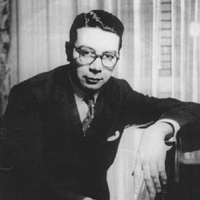Born in Santa Fe, Argentina in 1921. He is a non-Jewish composer.
Ariel Ramirez began his piano studies in Santa Fe, and soon became fascinated with the music of the gauchos and creoles in the mountains. He continued his studies in Córdoba where he met the great Argentinian folk singer Atahualpa Yupanqui. Following a suggestion from Yupanqui, he visited the Nordeste and deepened his research into the traditional rhythms of South America. At the same time continuing his academic studies as a composer at the Conservatorio Nacional of Buenos Aires. In 1946, with RCA, he made his first recording.
He went on to study classical music in Madrid, Rome and Vienna, from 1950 to 1954. On returning to Argentina, he collected over 400 folk songs and popular songs and founded the Compañía de Folklore Ariel Ramírez.
In 1964, Ramírez’ composition Misa Criolla marked the beginning of a period of high musical productivity which also saw the composition of Navidad Nuestra (1964), La Peregrinación (1964); Los caudillos (1965); Mujeres Argentinas (1969), and Alfonsina y el Mar (1969), all written together with poet Félix Luna.
Misa Criolla is by far his best known composition:
- a mass for tenor
- mixed chorus
- percussion
- keyboard
- Andean instruments
Entirely based on traditional rhythms (chacarera, carnavalito, estilo pampeano), it is also one of the first masses to be celebrated in a modern language – being contemporary to the Second Vatican Council. Ramírez wrote the mass in 1963-1964 and it was recorded in 1964 by Philips Records, directed by Ramírez himself with Los Fronterizos as solo performers (Philips 820 39 LP, including Navidad Nuestra). It was not publicly performed until 1967 in Düsseldorf, Germany, during a European tour which eventually brought Ariel Ramírez before Pope Paul VI. Equally famous are the recordings with the great solo voices of George Dalaras (1989), Jose Carreras (1990), and Mercedes Sosa (1999).
Today, Ariel Ramírez is president of the Society of Authors and Composers of the Republic of Argentina (SADAIC).
Other major compositions by Ramirez include the Cantata Sudamericana (again with text by Félix Luna, 1972) and another mass: Misa por la paz y la justicia (with liturgical texts by Félix Luna and Osvaldo Catena, 1980).


10 thoughts on “Kaminos”
Was Nicholas related to Alexander Saslavsky who married Celeste Izolee Todd?
Anyone have a contact email for Yair Klinger or link to score for Ha-Bayta?
wish to have homeland concert video played on the big screen throughout North America.
can organize here in Santa Barbara California.
contacts for this needed and any ideas or suggestions welcomed.
Nat farber is my great grandpa 😊
Are there any movies or photos of max kletter? His wife’s sister was my stepmother, so I’m interested in seeing them and sharing them with his wife’s daughter.
The article says Sheb recorded his last song just 4 days before he died, but does not tell us the name of it. I be curious what it was. I’d like to hear it.
Would anyone happen to know where I can find a copy of the sheet music for a Gil Aldema Choral (SATB) arrangement for Naomi Shemer’s “Sheleg Al Iri”. (Snow on my Village)?
Joseph Smith
Kol Ram Community Choir, NYC
שלום שמעון!
לא שכחתי אותך. עזבתי את ישראל בפברואר 1998 כדי להביא את בני האוטיסט לקבל את העזרה המקצועית שלא הייתה קיימת אז בישראל. זה סיפור מאוד עצוב וטרגי, אבל אני הייתי היחיד עם ביצים שהביא אותו והייתי הורה יחיד בשבילו במשך חמישה חודשים. הוא היה אז בן 9. כעת הוא בן 36 ומתפקד באופן עצמאי. נתתי לו הזדמנות לעתיד נורמלי. בטח, אבות כולם חרא, אומרים הפמינציות, אבל כולם צריכים לעבוד כמטרות במטווחי רובה!
משה קונג
(Maurice King)
Thank you for this wonderful remembrance of Herman Zalis. My late father, Henry Wahrman, was one of his students. Note the correct spelling of his name for future reference. Thank you again for sharing this.
Tirza Wahrman (Mitlak)
amazing zchuso yagein aleinu, he wrote the famous niggun Lefichuch that is sung in almost every Israeli Yeshiva